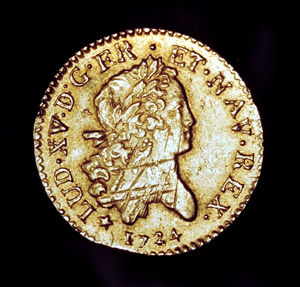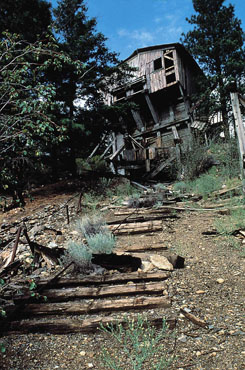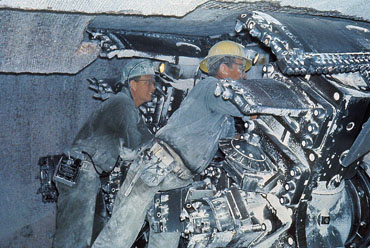Browse "Mining and Metallurgy"
-
Article
Gold
Gold (Au) is a bright, shiny, yellow metal, notable for its high density (19.3 times the weight of an equal volume of water) and valued for its extreme ductility, strong resistance to corrosion, lustrous beauty and scarcity.
"https://d2ttikhf7xbzbs.cloudfront.net/media/media/3c415394-d1cf-4ac7-88df-cc405447770a.jpg" // resources/views/front/categories/view.blade.php
https://d2ttikhf7xbzbs.cloudfront.net/media/media/3c415394-d1cf-4ac7-88df-cc405447770a.jpg
-
Article
Graphite
Graphite is one of the 4 allotropes of carbon. The other allotropes are Diamond, the fullerenes also known as "bucky balls" and amorphous carbon (charcoal, coke and carbon black). These allotropes of the same element carbon have very different crystal structures and physical properties. There are 2 types of graphite - natural and synthetic. Natural graphite is black with a sub-metallic lustre, feels greasy and stains the fingers. Graphite is found mainly in Metamorphic Rocks, most frequently in schist and as small crystals in impure marbles in association with other minerals.
"https://d2ttikhf7xbzbs.cloudfront.net/media/media/ccbf9884-f122-47b6-a979-572a2dfd24eb.jpg" // resources/views/front/categories/view.blade.php
https://d2ttikhf7xbzbs.cloudfront.net/media/media/ccbf9884-f122-47b6-a979-572a2dfd24eb.jpg
-
Article
Greenstone
Greenstone, general term for dark green, compact metamorphic rocks formed by the alteration of dark-coloured IGNEOUS ROCKS. Basalt, a common example, is a major component of the greenstone belts of the Canadian SHIELD. These belts contain the Shield's principal GOLD and base-metal mines.
"https://development.thecanadianencyclopedia.ca/images/tce_placeholder.jpg?v=e9dca980c9bdb3aa11e832e7ea94f5d9" // resources/views/front/categories/view.blade.php
https://development.thecanadianencyclopedia.ca/images/tce_placeholder.jpg?v=e9dca980c9bdb3aa11e832e7ea94f5d9
-
Article
Gypsum
The principal use for gypsum is wallboard. Crude gypsum is pulverized and heated to form stucco, which is mixed with water and aggregate (sand, vermiculite or expanded perlite) and applied over wood, metal or gypsum lath to form interior wall finishes.
"https://d2ttikhf7xbzbs.cloudfront.net/media/media/d296e1a0-9748-4a50-b6ea-9863ac520767.jpg" // resources/views/front/categories/view.blade.php
https://d2ttikhf7xbzbs.cloudfront.net/media/media/d296e1a0-9748-4a50-b6ea-9863ac520767.jpg
-
Article
Iron Ore
Its most important mineral forms are magnetite (Fe3O4, 72.4% Fe), hematite (Fe2O3, 69.9% Fe) and siderite (FeCO3, 48.29% Fe). In Brazil, some ore that contains practically no other minerals can grade as high as 68% Fe, but the crude ore mined in Canada grades between 30 and 44% Fe.
"https://d2ttikhf7xbzbs.cloudfront.net/media/media/0fa44cb9-3338-463a-ad5c-498dbf2d0950.jpg" // resources/views/front/categories/view.blade.php
https://d2ttikhf7xbzbs.cloudfront.net/media/media/0fa44cb9-3338-463a-ad5c-498dbf2d0950.jpg
-
Article
Limestone
Slaked lime is quicklime combined with water; this hydrated lime is then sized to meet customer specifications.
"https://development.thecanadianencyclopedia.ca/images/tce_placeholder.jpg?v=e9dca980c9bdb3aa11e832e7ea94f5d9" // resources/views/front/categories/view.blade.php
https://development.thecanadianencyclopedia.ca/images/tce_placeholder.jpg?v=e9dca980c9bdb3aa11e832e7ea94f5d9
-
Article
Mercury
Mercury (Hg) is a silvery white metal also known as quicksilver. Mercury is named for the Roman god of commerce, travel and thievery. It has been used for over 3000 years. Its chemical symbol, Hg, is derived from the Latin word hydrargyrum, which means "liquid silver.
"https://development.thecanadianencyclopedia.ca/images/tce_placeholder.jpg?v=e9dca980c9bdb3aa11e832e7ea94f5d9" // resources/views/front/categories/view.blade.php
https://development.thecanadianencyclopedia.ca/images/tce_placeholder.jpg?v=e9dca980c9bdb3aa11e832e7ea94f5d9
-
Article
Metallurgy
Metallurgy is the art, science and technology of turning metals and alloys (i.e., materials consisting of two or more metals) into forms suitable for practical use.
"https://d2ttikhf7xbzbs.cloudfront.net/media/media/3ed8d545-4edb-40bb-bc0e-6d7b68d6c22a.jpg" // resources/views/front/categories/view.blade.php
https://d2ttikhf7xbzbs.cloudfront.net/media/media/3ed8d545-4edb-40bb-bc0e-6d7b68d6c22a.jpg
-
Article
Mica
Phlogopite can be found in metamorphosed LIMESTONES, dolomites, serpentines and IGNEOUS ROCKS. It is light to dark brown and has properties and uses similar to muscovite.
"https://d2ttikhf7xbzbs.cloudfront.net/media/media/c877e97e-4b7c-48c5-b937-a17b8f6fde9b.jpg" // resources/views/front/categories/view.blade.php
https://d2ttikhf7xbzbs.cloudfront.net/media/media/c877e97e-4b7c-48c5-b937-a17b8f6fde9b.jpg
-
Article
Mineral Resources in Canada
Minerals are naturally occurring, homogeneous geological formations. Unlike fossil fuels, such as coal, oil and natural gas, minerals are inorganic compounds, meaning they are not formed of animal or plant matter. Canada is abundant in many mineral resources — mined in every province and territory — and a world leader in the production of potash, aluminum, cobalt, diamonds, gold platinum, uranium, among others.
"https://d2ttikhf7xbzbs.cloudfront.net/minerals/norandamineworker.jpg" // resources/views/front/categories/view.blade.php
https://d2ttikhf7xbzbs.cloudfront.net/minerals/norandamineworker.jpg
-
Article
Nepheline Syenite
Nepheline syenite is a white to light grey medium-grained IGNEOUS ROCK. It consists mostly of soda feldspar, nepheline and potash feldspar, accessory magnesium and iron-rich minerals.
"https://development.thecanadianencyclopedia.ca/images/tce_placeholder.jpg?v=e9dca980c9bdb3aa11e832e7ea94f5d9" // resources/views/front/categories/view.blade.php
https://development.thecanadianencyclopedia.ca/images/tce_placeholder.jpg?v=e9dca980c9bdb3aa11e832e7ea94f5d9
-
Article
Nickel
The major contemporary use for nickel is as an alloying agent. Nickel is present in some 3000 different alloys that are used in more than 250 000 end-use applications. The most popular alloy in which nickel is used is stainless steel (seeIRON AND STEEL INDUSTRY).
"https://d2ttikhf7xbzbs.cloudfront.net/media/media/cfafc49e-d0f9-4512-ab8e-9ccdab8fbada.jpg" // resources/views/front/categories/view.blade.php
https://d2ttikhf7xbzbs.cloudfront.net/media/media/cfafc49e-d0f9-4512-ab8e-9ccdab8fbada.jpg
-
Article
Platinum
Platinum (Pt) is the best known of the 6 greyish-white, metallic, platinum group elements, which also include palladium (Pd), iridium (Ir), rhodium (Rh), osmium (Os) and ruthenium (Ru). Platinum and palladium are more commonly used than the other elements in the group.
"https://development.thecanadianencyclopedia.ca/images/tce_placeholder.jpg?v=e9dca980c9bdb3aa11e832e7ea94f5d9" // resources/views/front/categories/view.blade.php
https://development.thecanadianencyclopedia.ca/images/tce_placeholder.jpg?v=e9dca980c9bdb3aa11e832e7ea94f5d9
-
Article
Potash
Potash is an alkaline potassium compound most commonly used in fertilizers. It refers to a variety of salts produced through mining of minerals and chemical manufacturing. Canada is the world's largest potash producer and exporter (see Exports from Canada). The country’s potash industry is located in Saskatchewan.
"https://d2ttikhf7xbzbs.cloudfront.net/media/media/cd668309-705d-44b0-a404-7a6c5242db9b.jpg" // resources/views/front/categories/view.blade.php
https://d2ttikhf7xbzbs.cloudfront.net/media/media/cd668309-705d-44b0-a404-7a6c5242db9b.jpg
-
Article
Salt
Sodium chloride (NaCl), or common salt, is ubiquitous in the environment. In its solid form, salt crystallizes as colourless cubes and is called rock salt. Salt is also known to geologists as halite. Its crystal structure was the first to be determined by X-rays.
"https://development.thecanadianencyclopedia.ca/images/tce_placeholder.jpg?v=e9dca980c9bdb3aa11e832e7ea94f5d9" // resources/views/front/categories/view.blade.php
https://development.thecanadianencyclopedia.ca/images/tce_placeholder.jpg?v=e9dca980c9bdb3aa11e832e7ea94f5d9
